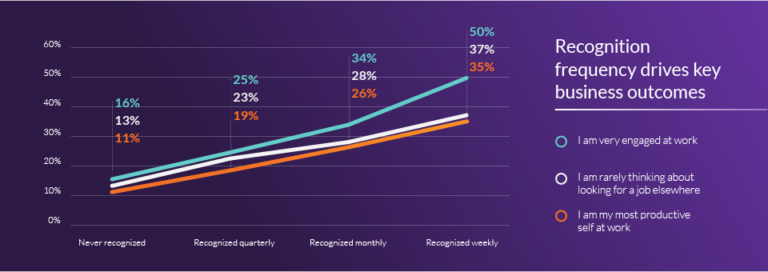Key takeaways
What are employee incentive programs?
Employee incentive programs are programs that motivate specific employee behaviors or outcomes. You can offer perks such as extra compensation, recognition, growth opportunities — as long as they are a reward for something a person or team does, they qualify as an incentive.
These programs are distinct from employee benefits, which are offered to everyone regardless of their achievements, though there may be some overlap. A company may offer 401K matching as a benefit to all employees every year, but it might offer an annual bonus only if the company hits its growth goals.
Most companies offer some form of employee incentives. As reported by the Society for Human Resource Management (SHRM), 93% of companies reported using short-term incentives, and 51% said they implemented long-term ones. These programs reward high-performing employees and give them tangible motivation to go above and beyond.
Benefits of incentives for employees
People are more likely to hit their goals if they know a reward is waiting for them at the end. Intrinsic motivation is important, but sometimes it’s not enough; when you can see the finish line, it’s much easier to make that final sprint.
Motivated employees are more engaged, more productive, and less likely to leave for new opportunities. In fact, 66% of employees reported that incentive programs inspired them to stay at their job, and there is a direct correlation between regular recognition and employee engagement.
A well-executed employee incentive program can make employees feel like their work matters on an organizational scale. Recognition is important for keeping employees happy, creating a sense of belonging, and reducing turnover.
Examples of employee incentive programs
The most effective incentives for your organization depend on your unique goals and budget. Some of the most common employee incentives include bonuses, recognition programs, professional development, and gifts and experiences.
Bonuses
Bonuses are extra compensation given to employees outside of their usual wages. The most common example of this is a performance bonus, where employees are rewarded with a lump sum for hitting specific KPIs. Similarly, commissions and profit-sharing can motivate employees to contribute to the company’s success.
Companies often provide sign-on bonuses to new employees and referral bonuses to reward those who recommend good job candidates. Some businesses will also offer annual or holiday bonuses at the end of the year.
Recognition programs
Recognition programs create an opportunity to acknowledge someone’s hard work or accomplishments without any monetary reward.
For example, company newsletters often spotlight people who go above and beyond, providing a regular opportunity for large-scale recognition. In addition, leaders may provide awards at quarterly or yearly meetings for performance or alignment with company values.
One-to-one recognition can be encouraged in informal ways, but it’s important to provide formal peer recognition opportunities. Many employee engagement software solutions have built-in systems and reminders for employees to send appreciation anonymously or publicly.
Some recognition programs also involve a points system, where moments of recognition can build up to redeeming larger rewards from other categories. Such systems incentivize recognizing smaller behaviors more frequently, which boosts employee motivation.
Professional development
Employees are not often incentivized by professional development; instead, this category describes the tactics used to incentivize professional development. Growing and expanding your job skills is always a good thing, but it can be difficult to make that a priority. Incentive programs can give employees the permission they need to focus on that growth.
Sometimes, this involves making resources available through your organization. E-learning sites and software frequently offer subscription plans for businesses, allowing leaders to provide an expanse of growth resources to their teams. Some companies also give out learning and development stipends to remove any monetary barriers to education.
As a more direct incentive, a company can also offer rewards for employees who complete certification programs relevant to their position. For long-time employees, some businesses also offer sabbatical leave as a perk, giving team veterans the time and space to pursue their development independently.
Gifts and experiences
Gifts and experiences are any tangible incentive outside of direct pay bonuses. This type of incentive must be selected with intention — generic company swag or activities can feel like a band-aid solution to employee dissatisfaction. Who needs another branded mug, right?
The type of gift or experience you choose should ideally be tied to the goal or accomplishment. For example, a new grill or outdoor furniture set might be an effective incentive for hitting summer sales goals. Or, an additional two weeks of PTO might be a compelling reason for employees to hit their two-year work anniversary.
Other popular gift and experience ideas to consider:
- Tickets to local events.
- Gift certificates.
- Subscription services.
- Workday parties.
- Catered lunches.
- Company-funded excursions.
- Extra days off.
Challenges of employee incentive programs
While employee incentive programs can be extremely effective for motivating employees, they may present additional challenges or risks if implemented incorrectly.
Lowering intrinsic motivation
Relying solely on extrinsic factors to spur employee behavior means that you will have to continue to provide those factors all of the time. You also need to inspire intrinsic motivation. Employees need to find the work meaningful in and of itself, which cannot be done with external rewards.
Incentivizing the wrong behavior
When implementing employee incentives, it’s crucial to consider what behavior you are actually incentivizing. If you don’t, you may end up with employees working hard to ensure the wrong results. Without proper guardrails, for example, commission-based incentives may lead a salesperson to employ unethical or untenable sales tactics, such as offering so many discounts that they diminish their margins.
Choosing the wrong incentives
For your incentive program to work, employees need to be interested in what you are offering. Every person and every team is different; it’s important to listen to what they want and offer incentives accordingly. If you don’t, they will be disinterested at best and insulted at worst.
It’s also important to pay attention to your biases when considering what incentives to offer so you don’t accidentally exclude employees. For example, incentivizing employees with a new fitness tracker or athletic equipment might exclude employees with physical disabilities. Consult your DEI committee to avoid this trap, and consider offering individualized or customizable incentives.
Employee engagement software can help you learn what incentives are most appropriate and effective for your employees. To get started, check out our Employee Engagement Software Guide.
Best practices for implementing employee incentive programs
When applied correctly, employee incentive programs can be a key element to help teams hit their goals and drive company success. Here are a few effective practices to keep in mind:
Find out what motivates your team
Above all, listen to your employees to learn what incentives will work best for them. Conducting surveys can help you determine the most effective incentive, as can one-on-one conversations with employees and managers. Not only will carefully choosing incentives provide better motivation, it’s also a great way to make employees feel heard.
Consider what you’re incentivizing
Before determining the reward you are offering, you must carefully consider what results you want to achieve and how you frame those goals. Talking to your middle managers can be good practice here; they will be able to anticipate questions or concerns and make predictions about how their teams will respond.
Have clear guidelines
Incentives are only effective if employees understand exactly what they must do to earn them. Provide clear guidelines about how and when incentives will be rewarded — is it a short-term incentive that only the top performers will receive? Or, is it something that everyone can earn when they reach a certain milestone? Avoid making changes to these guidelines after you’ve communicated them unless absolutely necessary.
Don’t rely on incentives alone
Incentives are useful, but their impact is short-lived. As such, it’s best to use them in conjunction with other employee satisfaction tactics like inclusive company culture initiatives, clear professional growth opportunities, and competitive compensation.






